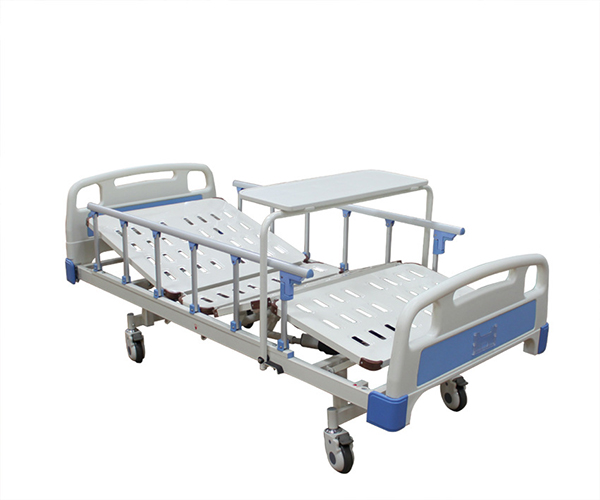1、 Core functions
Medical diagnosis and treatment bed is the basic equipment of hospitals, clinics and other medical places, mainly serving diagnosis, treatment, nursing and other scenarios. Its core functions can be summarized as follows:
1. Basic diagnosis and treatment support
Provide doctors with a stable platform for patients to lie down or sit, facilitating physical examinations (such as palpation and auscultation), punctures, dressing changes, sutures, and other procedures.
◦ Adapt to the needs of different departments: such as equipping gynecological diagnosis and treatment beds with leg rests, supporting stone cutting position examinations; Orthopedic diagnosis and treatment beds can be used in conjunction with traction equipment.
2. Position adjustment function
Multi dimensional angle adjustment: Through manual or electric control, it can achieve the lifting and angle adjustment of the head, tail, back, and legs of the bed (such as supine, side lying, and semi sitting positions), meeting the needs of different diagnosis and treatment postures (such as the left side lying position during gastroscopy examination).
◦ Height adjustable: Suitable for doctors to operate at a lower height (such as lower pediatric beds, making it easier for medical staff to operate up close), reducing bending and strain on medical staff.
3. Auxiliary diagnosis and treatment facilities
Attachment integration: Some diagnosis and treatment beds are equipped with detachable trays (for placing instruments or medical records), infusion rack interfaces, blood pressure monitor brackets, etc., to improve the convenience of diagnosis and treatment.
Special scenario adaptation: Emergency diagnosis and treatment beds are often equipped with mobile wheels (with brakes) to support rapid patient transportation; Some beds have built-in weighing modules that can monitor the patient’s weight in real-time.
4. Comfort and safety assurance
Buffer design: The mattress is made of non slip and breathable materials (such as high-density sponge or memory foam) to reduce the pressure of patients lying down for a long time.
◦ Safety protection: Set up guardrails beside the bed (especially for children and elderly patients) to prevent falls; The electric model is equipped with an emergency stop button to avoid accidents caused by operational errors.
2、 Main features
The design of medical diagnosis and treatment beds balances medical professionalism and user experience, with the following core features:
1. Modular functionality, adaptable to multiple scenarios
The diagnosis and treatment beds in different departments have exclusive functions:
Surgery/Emergency Department: Emphasize mobility (with swivel wheels) and load-bearing capacity (usually ≥ 150kg), partially supporting X-ray fluoroscopy (bed material transparent to X-rays).
Rehabilitation Department: The bed length can be adjusted and used in conjunction with rehabilitation training equipment such as tension ropes and training boards.
Dermatology: Some bed surfaces are made of anti fouling materials (such as PU leather) for easy cleaning and disinfection, avoiding cross infection.
2. Easy to operate, balancing efficiency and safety
Flexible control mode: The electric model supports bedside buttons and handheld remote control operation, and some high-end models can be connected to the hospital information system (HIS) to automatically record patient position data; The manual version can be adjusted through a hydraulic rod or gear structure, without the need for electricity, making it suitable for emergency situations.
Intelligent safety design: equipped with overload protection (electric models automatically stop when encountering resistance) and limit devices (angle adjustment with safety threshold), reducing operational risks.
3. Material and structure optimization to meet the needs of sensing and control
Easy to clean and disinfect: The surface of the bed is often made of stainless steel, ABS engineering plastic or anti fouling coating, which can be directly wiped with chlorine containing disinfectant to avoid bacterial growth (especially for infectious disease diagnosis and treatment scenarios).
Lightweight and Stability Balance: The aluminum alloy frame combined with high-strength plates reduces the weight of the bed (making it easy to move) while ensuring load-bearing capacity. Some parts of the bed bottom are equipped with antibacterial foot pads to reduce ground pollution.
4. Emphasize patient experience and embody humanistic care
Thoughtful detail design: rounded edges and corners (to avoid bumps), mattress thickness and softness adapted to ergonomics, reducing bed discomfort; The pediatric diagnosis and treatment bed can be designed with cartoon patterns to relieve children’s tension.
Privacy protection: Some beds are equipped with foldable screens or used in conjunction with partitions in the diagnosis and treatment room to respect patient privacy.
5. Integration of standardization and personalization
Adhere to medical equipment safety standards (such as GB 9706.1 General Requirements for Medical Electrical Equipment), while supporting customization: such as widened bed bodies for obese patients (conventional width 70-80cm, widened version can reach 100cm or more), bed body height matching design for wheelchair patients, etc.
3、 Summary
Although medical diagnosis and treatment beds may seem “basic”, their functions and design directly affect diagnosis and treatment efficiency, patient comfort, and medical operation convenience. From manual to electric intelligent upgrade, from single support to modular integration, modern medical diagnosis and treatment beds are developing towards the direction of “precise adaptation, safety and convenience, and humanistic care”, becoming an indispensable “silent assistant” in medical scenes. Whether it is basic examinations in grassroots clinics or complex diagnosis and treatment in tertiary hospitals, the core value always revolves around “patient-centered, medical needs oriented”, reflecting professionalism and warmth in details.
Post time: Jun-04-2025



